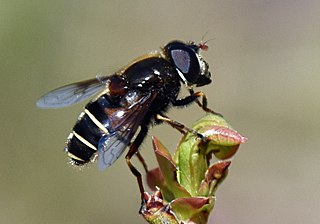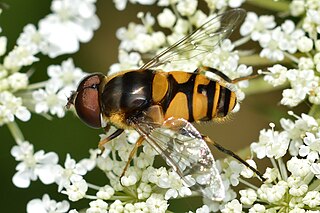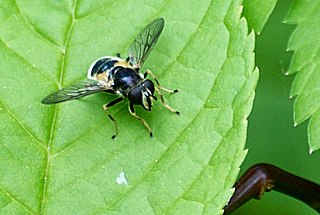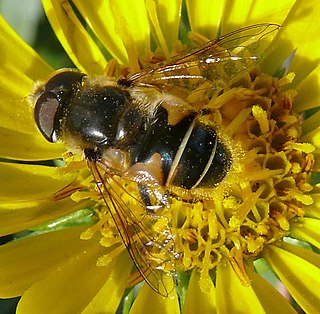
Spilomyia sayi, the Four-lined Hornet Fly, is a fairly common species of syrphid fly. This species is found from western Canada to northeastern North America. Hoverflies get their names from the ability to remain nearly motionless while in flight. The adults are also known as flower flies for they are commonly found around and on flowers, from which they get both energy-giving nectar and protein-rich pollen. The larvae are known as the short-tailed larvae, suited for moist areas such as rot holes of trees. It is a wasp mimic.

Eristalis cryptarum is a holarctic species of hoverfly. Known as the bog hoverfly or bog-dwelling drone fly, it is a bog specialist but may occur in other wetlands. Its larvae are assumed to live in peat that is saturated with water, such as that found in these boggy areas. The female has been observed depositing eggs on and close to very fresh cow dung along oligotrophic seepages in moorland.

Eristalis flavipes, the orange-legged drone fly, is a species of hoverfly native to North America. It flies from early April to mid-October, and occurs in a wide variety of habitats, particularly wetlands. Hoverflies get their names from the ability to remain nearly motionless while in flight. The adults are also known as flower flies for they are commonly found around and on flowers, from which they get both energy-giving nectar and protein-rich pollen. The larvae are aquatic filter-feeders of the rat-tailed type.

Brachyopa flavescens, The Yellow Sapeater, is a fairly common species of syrphid fly. It has been observed in northeastern North America. Hoverflies get their names from the ability to remain nearly motionless while in flight. The adults are also known as flower flies for they are commonly found around and on flowers, from which they get both energy-giving nectar and protein-rich pollen. Larvae for this genus are of the rat-tailed type. B.flavescens larvae have not been described.

Palpada vinetorum is a species of syrphid fly in the family Syrphidae. It is a native flower fly species to North America, mainly found in Texas and parts of the east coast.

Helophilus fasciatus, the narrow-headed marsh fly, is an abundant species of syrphid fly observed throughout the United States and Canada. Hoverflies can remain nearly motionless in flight. The adults are also known as flower flies for they are commonly found on flowers, from which they get both energy-giving nectar and protein-rich pollen. The larvae of this genus are associated with wet decaying organic material, particularly accumulations of decaying vegetation in ponds and mud and farmyard manure or silage. The adults of this species lays eggs on vegetation overhanging the water. The larvae hatch and drop into the water.

Eristalis transversa, the transverse banded drone fly, is a common species of syrphid fly first officially described by Wiedemann in 1830. Hoverflies get their names from the ability to remain nearly motionless while in flight. The adults are also known as flower flies for they are commonly found around and on flowers, from which they get both energy-giving nectar and protein-rich pollen. The larvae are rat-tailed type but larvae of this specific species has not been reported.

Helophilus lapponicus, the Yellow-margined Marsh Fly, is a common species of syrphid fly observed across northern North America, northern Europe, Greenland and Siberia. Hoverflies can remain nearly motionless in flight. The adults are also known as flower flies for they are commonly found on flowers, from which they get both energy-giving nectar and protein-rich pollen. Though common the larvae of this species are not known but the larvae of other species in this genus are associated with wet decaying organic material, particularly accumulations of decaying vegetation in ponds and mud and are a so called rat-tailed type.

Blera umbratilis, the Hairy Wood Fly, is an uncommon species of syrphid fly first officially described by Williston in 1887. Hoverflies get their names from the ability to remain nearly motionless while in flight. The adults are also known as flower flies for they are commonly found around and on flowers, from which they get both energy-giving nectar and protein-rich pollen. The larvae are of the rat-tailed type, feeding on exuding sap or in the rot holes of trees.

Arctosyrphus willingii, the northern longbeak, is a species of rat-tail maggot fly in the family Syrphidae. This species was formerly a member of the genus Lejops.

'Dasysyrphus intrudens' is a placeholder name for a complex of hover fly species that have yet to be properly been divided into individual species. It is found in the Holarctic realm. Though this species actually a complex, it is commonly found in many areas of its range, but yet the larvae of this species were not known to science as of 2012. This may be due to the probable nocturnal habit of these larvae if it is similar to some known larvae of this genus.

Blera pictipes, the Painted Wood Fly, is a rare species of syrphid fly first officially described by Bigot in 1883. Hoverflies get their names from the ability to remain nearly motionless while in flight. The adults are also known as flower flies for they are commonly found around and on flowers, from which they get both energy-giving nectar and protein-rich pollen. The larvae are of the rat-tailed type, feeding on exuding sap or in the rot holes of trees.

Brachyopa daeckei, the black-tailed sapeater, is a rare species of syrphid fly that has been observed in northeastern North America. Hoverflies get their names from the ability to remain nearly motionless while in flight. The adults are also known as flower flies for they are commonly found around and on flowers, from which they get both energy-giving nectar and protein-rich pollen. Larvae for this genus are of the rat-tailed type. B.daeckei larvae have not been described.

'Blera confusa , the confusing Wood Fly, is a common species of syrphid fly first officially described by Johnson, 1913 Hoverflies get their names from the ability to remain nearly motionless while in flight. The adults are also known as flower flies for they are commonly found around and on flowers, from which they get both energy-giving nectar and protein-rich pollen. The larvae are of the rat-tailed type feeding on exuding sap or in the rot holes of trees.

Blera robusta, the Greenish Wood Fly, is a rare species of syrphid fly first officially described by Curran in 1922. Hoverflies get this name from the ability to remain nearly motionless while in flight. The adults are also known as flower flies, for they are commonly found around and on the flowers from which they get both energy-giving nectar and protein rich pollen. The larvae are of the rat-tailed type, feeding on exuding sap or in the rot holes of trees.
Blera analis, the Orange-tailed wood fly, is an uncommon species of syrphid fly. It was officially described by Macquart, 1842. Hoverflies get their names from their ability to remain nearly motionless while in flight. The adults are also known as flower flies for they are commonly found around and on flowers from which they get both energy-giving nectar and protein-rich pollen. The larvae are of the rat-tailed type feeding on exuding sap or in the rot holes of trees.

Helophilus obscurus , the Obscure Marsh Fly, is a common species of syrphid fly observed throughout Canada and the northern United States and Rocky Mountains. Hoverflies can remain nearly motionless in flight. The adults are also known as flower flies for they are commonly found on flowers, from which they get both energy-giving nectar and protein-rich pollen. The larvae of this genus are associated with wet decaying organic material, particularly accumulations of decaying vegetation in ponds and mud and farmyard manure or silage the larvae of this species are not known.

Eristalis hirta, the black-footed drone fly, is a common Western North American species of syrphid fly, first officially described by Loew in 1866. Hoverflies get their names from the ability to remain nearly motionless while in flight. The adults are also known as flower flies as they are commonly found on and around flowers, from which they get both energy-giving nectar and protein-rich pollen. The larvae are aquatic filter-feeders of the rat-tailed type.
'Blera metcalfi , Metcalf's wood fly, is a rare species of syrphid fly first officially described by Curran in 1925 Hoverflies get their name from the ability to remain nearly motionless while in flight. The adults are also known as flower flies for they are commonly found around and on flowers from which they get both energy-giving nectar and protein rich pollen. The larvae are of the rat-tailed type feeding on exuding sap or in the rot holes of trees.
Microdon ocellaris, the hairy-legged ant fly, is a rare species of syrphid fly observed in the eastern United States. Hoverflies can remain nearly motionless in flight. The adults are also known as flower flies for they are commonly found on flowers, from which they get both energy-giving nectar and protein-rich pollen. The larvae have been found in the nests of Formica pallidefulva.

















